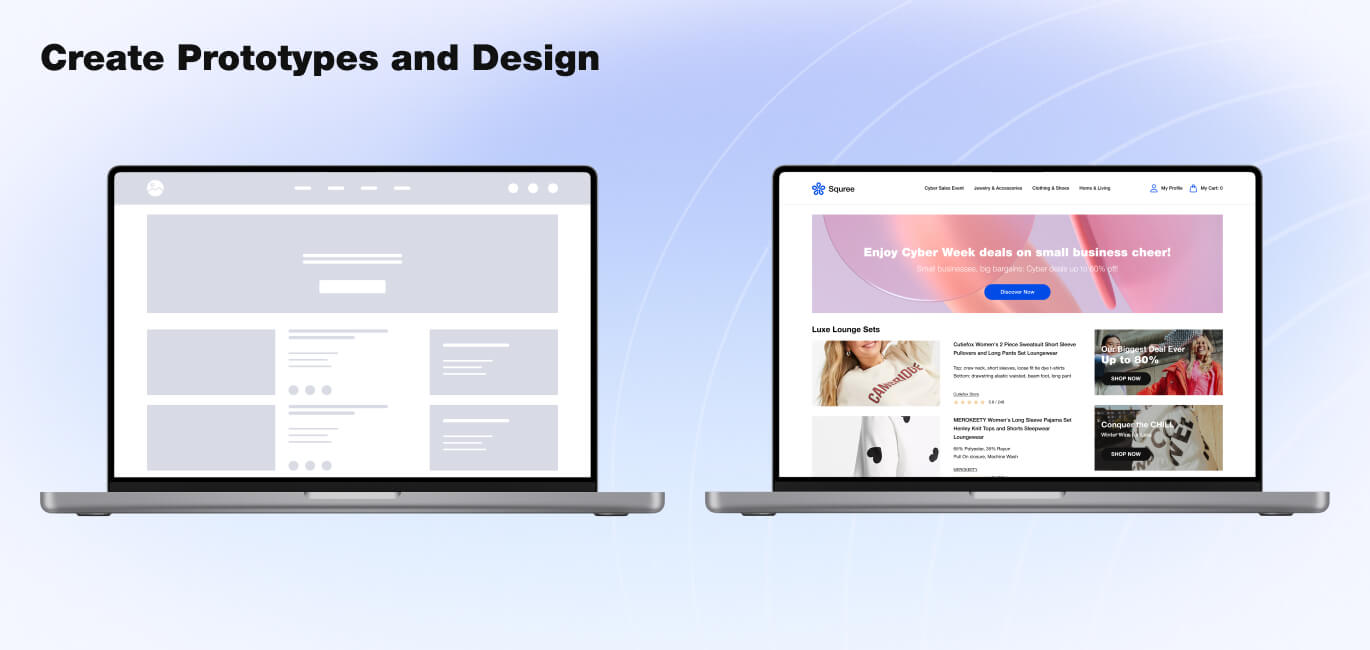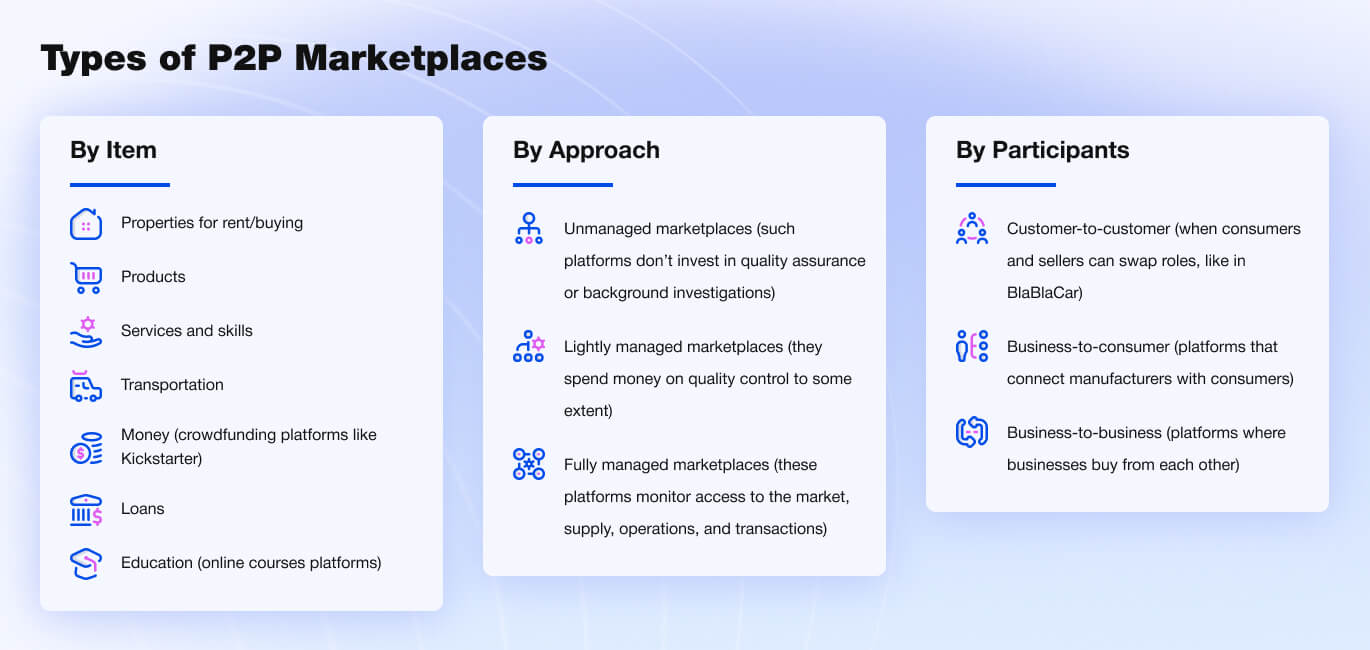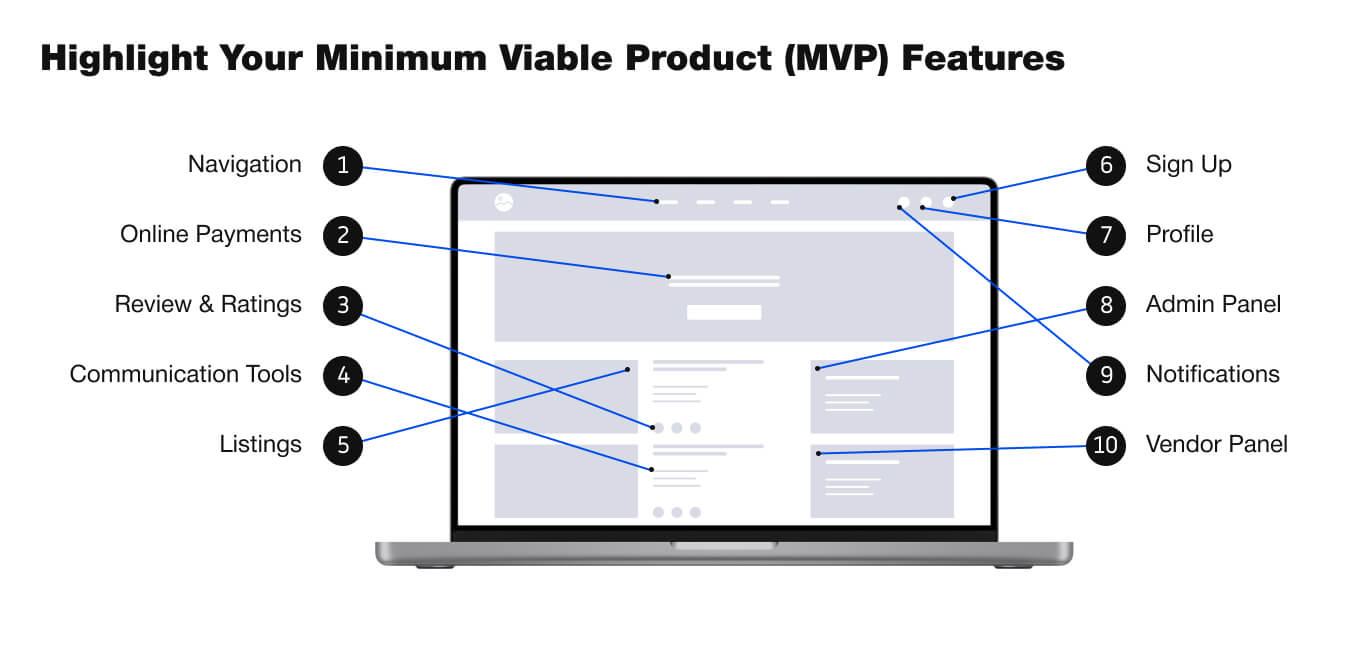How to Build a Peer-to-Peer (P2P) Marketplace
 30 November 2021
30 November 2021The e-commerce market has been steadily growing, and this trend will only get stronger in the next few years. People are increasingly choosing to buy online, which makes this market a rewarding investment. However, peer-to-peer marketplace platforms are expanding fast, crowding out traditional online stores. That’s why more and more aspiring entrepreneurs want to learn how to make a peer-to-peer e-commerce website. This article will help you gain useful insights into all the stages related to developing a peer-to-peer website.
What Is a Peer-to-Peer (P2P) Marketplace?
The easiest way to answer this question is to compare a classic online store and a P2P one. So, in a typical store, you decide on the services or goods you’re going to sell, set prices, maintain the process, etc. But with a two-sided marketplace business model, you don’t need to own the product or service. You create a space where supply meets demand. Within the space, two groups of people connect: those who provide specific services or goods and those who need them.
Advantages of P2P Marketplace Over Typical Online Stores
Let’s start with P2P marketplace advantages for you to get a clearer idea of how it all works.
P2P Market
Just by looking at the statistics of the P2P market and its key players, it becomes obvious that their revenue grows annually. Here’s the list of its most famous and successful members:
- Amazon
This business had a quite humble beginning as an online bookstore back in 1995. Now you can sell or buy anything worldwide there, from designer bags to cat food.Recently, it has made it to the trillion-dollar companies club with a net worth of $2.08 trillion, along with Apple and Microsoft. - Airbnb
Based in the USA, this P2P marketplace platform helps travelers easily find affordable accommodation all over the world. They boast more than 300 million guest check-ins over the last 10 years. - Etsy
This one focuses on selling handmade or vintage things. It was created back in 2005 and has become the most popular place for craftspeople to find buyers. The company charges listing fees and gets a percentage of each sale. - AliExpress
The e-commerce platform connects Chinese retailers with buyers and manufacturers all over the world. Since costs of production are considerably lower in China, many goods come at a lower price. In 2020, AliExpress’s revenue for GMV (Gross Merchandise Value) reached a historic $1 trillion. - Uber
This most successful on-demand taxi service is a digital aggregator app platform that connects drivers with passengers who need a ride. The company also provides on-demand food delivery via Uber Eats and on-demand trucking via Uber Freight.
Financial Benefit
Developing a two-sided marketplace demands minimum effort but promises a good profit. You don’t have to deal with setting up production, shipping issues, finding suppliers of goods, or creating a smooth service process. Your main goal is to come up with a software solution that offers exceptional functionality. Then you attract your first visitors, and the business is off the ground.
High Demand
As mentioned before, people keep buying more and more online. And obviously, they want to save money. By building a peer-to-peer marketplace, you erase any intermediaries between vendors and the end buyers. This cut costs on commissions, which makes products or services cheaper. So, buyers spend less money, but vendors get more customers or clients. It’s a win-win situation for everyone involved.
Scalable Business and Monetization Models
A peer-to-peer marketplace platform gives you an easy way for scaling since you’re not tied to just one product or service or a group of them. Plus, many leading players of the P2P market started locally and then developed into global companies.
As for monetization models, there are several of them that are highly attractive for vendors:
- Receiving commissions
- Subscriptions-based model
- Listing fee model
- Featured listings model (for a P2P marketplace in a narrow niche)
Scalable Business and Monetization Models
Since each new user increases the overall value of the P2P platform, the business has a network effect. It gives an opportunity for significant growth and quicker scaling. More customers mean more demand, which attracts more suppliers. More suppliers mean a wider choice for buyers. This, in turn, creates a better customer experience, bringing in more shoppers.
Types of P2P Marketplaces
We can categorize P2P marketplaces by several points: by items, by participants, and by approach.
By item:
- Properties for rent/buying
- Products
- Services and skills
- Transportation
- Money (crowdfunding platforms like Kickstarter)
- Loans
- Education (online courses platforms)
By participants:
- Customer-to-customer (when consumers and sellers can swap roles, like in BlaBlaCar)
- Business-to-consumer (platforms that connect manufacturers with consumers)
- Business-to-business (platforms where businesses buy from each other)
By approach:
- Unmanaged marketplaces (such platforms don’t invest in quality assurance or background investigations)
- Lightly managed marketplaces (they spend money on quality control to some extent)
- Fully managed marketplaces (these platforms monitor access to the market, supply, operations, and transactions)
How To Build a Peer-to-Peer Marketplace Website?
When it comes to P2P marketplace website development, there are five stages of this project.
1Conduct Competitor and Market Research
Before you get into the actual making of a P2P e-commerce website, you have to validate your business idea. Ensuring that your customers need your solution will save you from unwanted losses.
Things to consider in your research:
- Demand: Is there a need for your peer-to-peer (P2P) marketplace? What group of customers will benefit from it?
- Market size: How large is that group?
- Market saturation: How many similar platforms already exist?
- Analyze competitors’ platforms: What is the user experience like on their website? What are their pros and cons? What do their reviews say?
- Identify areas for improvement: What can you do better than your competitors?
After gathering all this information, make a SWOT (Strengths, Weakness, Opportunities, and Threats) analysis.
| Strengths | Weaknesses | Opportunities | Threats |
|---|---|---|---|
| How is your platform better than competitors’? | Which part of your business idea needs improvement? | Which trends do you think can bring you new opportunities? | Are there competitors in the market who can cut down your business? |
| What is unique about your platform? | Do you lack subject matter expertise? | How can you target those customers who are not satisfied with your competitors? | What challenges will you face? |
2Highlight Your Minimum Viable Product (MVP) Features
A Minimum Viable Product (MVP) is the earliest version of the platform you start a P2P marketplace website with. When you’ve done a SWOT analysis, you should be able to identify its main features. Most P2P marketplace websites have these features:
| Feature | Description |
|---|---|
| Sign up/Sign in | The initial stage of user experience on your website that leads to creating their personal account (profile) for storing their personal information, purchase history, etc. There are many different solutions for it. Signing in with Google or a Facebook account is considered to be a more convenient and faster option. Also, consider implementing some kind of verification, especially for vendors. |
| Profile | A profile page with users’ personal information: name, age, contacts, location, etc. |
| Listing pages | For vendors to showcase what they’re offering with the help of videos, descriptions, and pictures. It also should have an option for buyers to add an item to the cart or wishlist. |
| Website navigation and search | For users to find what they need through keyword or location-based search. Alternatively, you need to determine how to best categorize your listings for users to navigate. |
| Notifications | They are important for timely order completion. Sellers need to know when they have a new order, and customers should be notified when the price has dropped or when the tracked item is available again. |
| Online payments | You’ll need to integrate a payment gateway that’s secure and reliable. |
| Reviews and ratings | They are crucial for building trust between users. |
| Tools for communication between sellers and buyers | A messaging service that supports multiple real-time conversations will enhance the experience of both sides and help avoid disputes. |
| Admin features | To moderate profiles and listings, control user access, see your transaction processes, send notifications, etc. |
| Vendor panel | For vendors to manage their product listings and sales. |
| Buyer-only features | |
| Wishlist | This can be a list of favorited items or services |
| Bookings (if available) | This is a must-have for rental or on-demand services. |
| History of purchases | Buyers need it to keep track of their purchases with dates and other details. |
3Create Prototypes and Design

When you have a list of features you need, it’s time to create a prototype of the platform. This will be a general website model visualizing all features and layout elements. Thanks to it, you can change and finalize the platform at a minimal cost. In addition to that, you can estimate the timeframe and expenses for the scope of work more precisely.
The low-fidelity prototype is mainly for checking and testing functionality. At this stage, you can add some other features that you might have overlooked before. The simplest form of clickable, interactive prototype is a wireframe.
After that, you can move to a high-fidelity prototype, which is characterized by detailed UI design, real content, and real interactivity. Now, start testing UI elements and interactions to gain meaningful feedback from test participants. If something isn’t the way you planned, you can make the required adjustments.
4Develop an MVP Version
There are several reasons why developing the MVP version is important:
- It’s developed quickly and inexpensively. You can even launch several versions to run A/B tests.
- You don’t waste time meticulously creating a website just to find out it’s not convenient for real users.
- Since you don’t invest much money in MVP development services, you can easily make changes to the platform in the initial stages without wasting resources.
- If you’re looking for funding, having a working model of your idea will help you gain support.
5Keep Improving
As you can guess, launching an MVP version of your P2P online marketplace isn’t the end of the story. The only way to succeed is to constantly strive for improvement. And you can’t do it without deep knowledge about who your users are and how they behave.
Gather user engagement metrics, such as session length, session interval, acquisitions, retention rate, customer satisfaction score (CSAT), customer effort score, and churn rate. Analyzing it will lead to adding valuable functionality to your website — thus helping you grow the user base while keeping the balance between sellers and buyers.
How Much Does It Cost to Make a P2P Marketplace Website?
While making a P2P e-commerce website, you have two main options that affect its cost: use ready-made platforms, or build it from scratch. Both of them have pros and cons.
1Ready-made websites
You can take open-source solutions, such as Mayocat, and adapt them to your needs.
Pros:
- It’s a simple solution with a fast development process.
- Simplicity and a ready solution mean you save money.
Cons:
- Typical design.
- It’s more difficult to scale.
- You need to hire an expert for adapting the open-source software to your needs.
The cost to create a peer-to-peer marketplace using off-the-shelf solutions is relatively low. But your website won’t have any custom features.
Here you can find our ready-made marketplace solution.
2Built-from-scratch P2P marketplace platforms
A custom-developed product is a must if you have a unique idea for your future two-sided website.
Pros:
- You can go a non-standard way.
- You can easily extend the platform’s functionality.
- Slow speed and slowdowns won’t be a problem for you.
Cons:
- You need a software development team.
- It’s expensive and can take a long time.
So, how expensive is it actually? The answer to this question is highly dependent on the desired functionality, which involves different tech stacks and UI/UX design requirements.

Let’s say you go for a standard pack of features we’ve talked about before. Then your core development team will consist of:
- Product/Project manager. Their main responsibility is to manage the processes and team members. They also conduct marketing research at the initial stage.
- Front-end developers. Their main responsibility is to develop and maintain the user interface (UI).
- Beck-end developers. They manage the operational logic of the app and data use, including the server and cloud storage.
- UI/UX designer. Their role is to create the best user-centered designs possible for the website and that are aligned with business requirements.
- Quality Assurance Engineer. They test, review, and access the platform.
Typically, you won’t need more than one of each expert to build a marketplace website unless your deadline is tight. Here are the average web development hourly rates by region:
| Location | Rates |
|---|---|
| North America | $74-200 |
| Western Europe | $60-150 |
| Eastern Europe | $25-50 |
| Latin America | $40-60 |
| Asia | $20-$40 |
To estimate the full cost of creating a P2P platform, let’s see how much time you need to build each feature:
| Feature | Average time to build (hours) |
|---|---|
| Homepage | 15 |
| Registration and Login (+ social integration) | 33 |
| Vendor Panel | 50 |
| Checkout | 70 |
| User Account | 38 |
| Product/Service Page | 40 |
| Product visual customization/visualization | 65 |
| Payments Integration | 30 |
| Simple Loyalty Program (Gifts) | 20 |
| Responsiveness | 40 |
| Another product type cusomization/visualization | 15 |
| Coupons | 10 |
| Multilingual Support | 60 |
| Admin Control Panel | 150 |
| Total | 636 |
So, it’ll take somewhere around two months to build the main features. Add to this time for creating a design, prototypes, and quality control. You’ll end up with a timeframe between three to four months, depending on the number of features and the expertise of developers.
In the end, the total sum starts from $28,000. There are additional costs that include:
- Domain name
- Hosting
- Maintenance
How to Mitigate Risks in P2P Website Development?
There are several tips that can help you avoid specific pitfalls on your way to success.
Focus on Your Expertise
You should know all the ins and outs of the niche you’ve chosen. Whatever it might be, dive in deeper to use your knowledge at every stage of P2P marketplace development.
Do Pre-launch Homework and Use Marketing
Before you launch, work on starting a P2P marketplace website effectively by attracting sellers. Try to form a base of vendors who can suggest goods or services without expecting to get any sales at once. You can do it using these options:
- Get in touch with sellers who provide goods or services for competitive marketplaces.
- Find providers for your unique niche using business directories and Google search.
- Check related Facebook groups and forums.
You will also want to build loyalty to your platform in advance by reaching out to your potential buyers in these ways:
- Gather emails by setting a pre-launch landing page.
- Involve influencers of your target audience to promote your marketplace.
- Create your own blog or community.
Consider SEO at the Development Stage
This will help your website rank high on Google and get good conversion rates to attract more potential buyers. SEO optimization includes:
- Composing a semantic core and group keywords according to different pages.
- Checking pages for indexation, web site map, 404 errors, and 301 redirects.
Analyze the Behavior of Your Site Visitors
The simplest way is to use Google Analytics. It can provide information about how people are getting to your site. Google Analytics also creates the Behavior Flow report to let you know what exactly visitors do on your website. This report shows you what actions lead to conversions. It will also spot roadblocks that make visitors leave your website. After gaining these insights, you can work on removing those roadblocks.
Summary
Hopefully, you’ve got the answers to the question “How to create a peer-to-peer website?” Now is one of the most successful directions that business owners are actively exploring. Building an online marketplace does require a lot of effort and well-coordinated teamwork if you choose to go your own unique way. But there’s no single correct decision when it comes to business. Regardless of your resources and time, you can still achieve great results.
Drop us a line and let’s discuss your idea.












